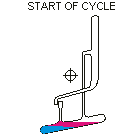CONTER CURRENT EXTRACTION
Countercurrent Extraction - Craig Apparatus.
Theory A method of multiple liquid-liquid extractions is countercurrent extraction, which permits the separation of substances with different distribution coefficients (ratios). A clever design known as Craig apparatus is used for this purpose (Lyman C. Craig, 1943). Craig apparatus consists of a series of glass tubes (r: 0, 1, 2..) that are designed and arranged such that the lighter liquid phase is transferred from one tube to the next. The liquid-liquid extractions are taking place simultaneously in all tubes of the apparatus which is usually driven electromechanically. In the following animated picture of a single glass tube the typical "extraction/transfer" cycle is shown. The lower (heavier) phase of the two-phase solvent system (e.g. water, blue layer in the picture) is the "stationary phase", whereas the upper (lighter) phase (e.g. hexane, red layer in the picture) is the "mobile phase". In the beginning, tube #0 contains the mixture of substances to be separated in the heavier solvent and all the other tubes contain equal volumes of the same solvent. The lighter solvent is added to tube #0, extraction (equilibration) takes place and the phases are allowed to separate. The upper phase of tube #0 is then transferred to tube #1 and fresh solvent is added to tube #0, and the phases are equilibrated again. The upper layers of tubes #0 and #1 are simultaneously transferred to tubes #1 and #2 respectively. This cycle is repeated to carry on the process through the other tubes of the apparatus. Obviously, substances with higher distribution ratio move faster than those with a lower distribution ratio. It is interesting to examine the distribution of a substance A in each tube after a given number of equilibration/transfer cycles. |

Comments
Post a Comment